Lexus ES250 1999, ES300 1999, ES330 1999, ES350 1999 Owner Manual

SECTION 6 ± 5
SERVICE PROCEDURES AND
SPECIFICATIONS
Body
Specifications . . . . . . . . . . . . . . . . . . . . . . . . . . . . . . . . 443
Protecting your vehicle from corrosion . . . . . . . . . . . 444
Washing and waxing . . . . . . . . . . . . . . . . . . . . . . . . . . 446
Cleaning the interior . . . . . . . . . . . . . . . . . . . . . . . . . . . 447
442

BODY
SPECIFICATIONS
± DIMENSIONS AND WEIGHT
Overall length |
4830 mm (190.2 in.) |
Overall width |
1790 mm (70.5 in.) |
Overall height |
1395 mm (54.9 in.)* |
Wheelbase |
2670 mm (105.1 in.) |
Tread ± Front |
1545 mm (60.8 in.) |
± Rear |
1520 mm (59.8 in.) |
Vehicle capacity weight (occupants + luggage) |
410 kg (900 lb.) |
|
|
*: Unladen vehicle |
|
± FUEL TANK |
|
|
|
Capacity |
70 L (18.5 gal., 15.4 lmp.gal.) |
|
|
443

BODY
PROTECTING YOUR VEHICLE
FROM CORROSION
exposed to high temperature.
Proper care of your Lexus can help ensure long±term corrosion prevention.
The most common causes of corrosion to your vehicle are:
The accumulation of road salt, dirt and moisture in hard±to±reach areas under the vehicle.
Chipping of paint or undercoating caused by minor accidents or by stones and gravel.
The following conditions will cause or accelerate corrosion of your vehicle, so it is important to keep your vehicle, particularly the underside, as clean as possible and to repair any damage to paint or protective coatings as soon as possible.
The presence of road salt or dust control chemicals, salt in the air near the sea coast, industrial air pollution.
High humidity, especially at temperatures just above freezing point.
Certain parts of your vehicle are wet or damp for an extended period of time, even though other parts of the vehicle are dry.
Components of the vehicle which are prevented from quick±drying due to lack of proper ventilation are
444

BODY
To help prevent corrosion on your Lexus, follow these guidelines:
Keep your vehicle clean by regular washing. In addition, observe the following points.
If you drive on salted roads in the winter or if you live near the ocean, you should hose off the undercarriage at least once a month to minimize corrosion.
High pressure water or steam is effective for cleaning the vehicle's underside and wheel housings. Pay particular attention to these areas as it is difficult to see all the mud and dirt. It will do more harm than good to simply wet the mud and debris without removing them. The lower edge of doors, rocker panels and frame members have drain holes which should not be allowed to clog with dirt as trapped water in these areas can cause corrosion.
Wash the underside of the vehicle thoroughly when winter is over.
See ºWashing and waxingº for more tips.
Check the condition of your vehicle's paint and trim.
If you find any chips or scratches in the paint, touch them up immediately to prevent corrosion from starting. If the chips or scratches have gone through the bare metal, have a qualified body shop make the repair.
Check the interior of your vehicle. Water and dirt can accumulate under the floor mats and could cause corrosion. Occasionally check under the mats to make sure the area is dry. Be particularly careful when transporting chemicals, cleansers, fertilizers, salt, etc. These should be transported in proper containers. If a spill or leak should occur, immediately clean and dry the area.
Keep your vehicle in a well ventilated garage or a roofed place. Do not park your vehicle in a damp, poorly ventilated garage. If you wash your vehicle in the garage, or if you drive it in covered with water or snow, your garage may be so damp it will cause corrosion. Even if your garage is heated, a wet vehicle can corrode if the ventilation is poor.
445
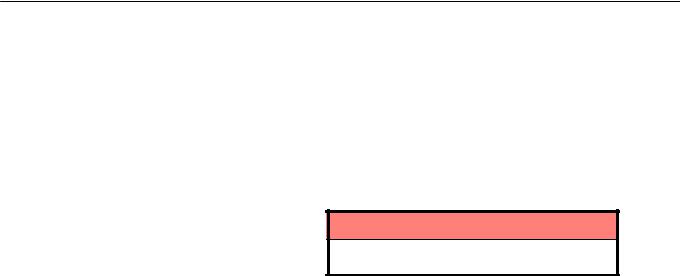
BODY
WASHING AND WAXING
Washing your Lexus
Keep your vehicle clean by regular washing.
The following cases may cause weakness to the paint or corrosion to the body and parts. Wash your vehicle as soon as possible.
When driving in a coastal area
When driving on a road sprinkled with antifreeze
When having stuck of coal tar, tree sap, bird droppings and carcass of an insect
When driving in the areas where there is a lot of smoke, soot, dust, iron dust and chemical substance
When the vehicle becomes remarkably dirty with dust and mud
Hand±washing your Lexus
Work in the shade and wait until the vehicle body is not hot to the touch.
1. Rinse off loose dirt with a hose. Remove any mud or road salt from the underside of the vehicle or in the wheel wells.
2. Wash with a mild car±wash soap, mixed according to the manufacturer's instructions. Use a soft cotton mitt and keep it wet by dipping it frequently into the wash water. Do not rub hard ± let the soap and water remove the dirt.
Aluminum wheels: Use only a mild soap or neutral detergent.
Urethane bumpers and side moldings: Wash carefully. Do not scrub with abrasive cleaners. The bumper and side molding faces are soft.
Road tar: Remove with turpentine or cleaners that are marked safe for painted surfaces.
NOTICE
Do not use gasoline or strong solvents, which may be toxic or cause damage.
3.Rinse thoroughly ± dried soap can cause streaking. In hot weather you may need to rinse each section right after you wash it.
4.To prevent water spots, dry the vehicle using a clean soft cotton towel. Do not rub or press hard ± you might scratch the paint.
446

BODY
Automatic car wash |
CLEANING THE INTERIOR |
Your vehicle may be washed in an automatic car wash, but remember that the paint can be scratched by some type of brushes, unfiltered washing water, or the washing process itself. Scratching reduces paint durability and gloss, especially on darker colors. The manager of the car wash should be able to advise you whether the process is safe for the paint on your vehicle.
Waxing your Lexus
Polishing and waxing is recommended to maintain the original beauty of your Lexus' finish.
Once a month or if the vehicle does not repel water well, apply wax.
1.Always wash and dry the vehicle before you begin waxing, even if you are using a combined cleaner and wax.
2.Use a good quality polish and wax. If the finish has become extremely weathered, use a car±cleaning polish, followed by a separate wax. Carefully follow the manufacturer's instructions and precautions. Be sure to polish and wax the chrome trim as well as the paint.
3.Wax the vehicle again when water does not bead but remains on the surface in large patches.
447

BODY
CAUTION
Be careful not to splash water or spill liquid on the floor. This may prevent the side airbags from activating correctly, resulting in serious injury.
Do not wash the vehicle floor with water, or allow water to get onto the floor when cleaning the vehicle interior or exterior. Water may get into audio components or other electrical components above or under the floor carpet (or mat) and cause a malfunction; and it may cause body corrosion.
448

BODY
Leather Interior
NOTICE
The selected leather is used in your Lexus. Due to a leather product, some parts of leather may be rough, uneven or scratched originally.
To keep good appearance, we recommend you to clean it periodically twice a year.
Remove dirt on the leather in the following ways:
1.Wipe it off lightly using a soft cloth (e.g. gauze) dampened with 5% solution of neutral detergent for wool.
2.Wring water from a clean cloth and thoroughly wipe off all traces of detergent with it.
3.Wipe off the surface of the leather with a dry soft cloth. Allow the leather to dry in a ventilated shaded area. Excess of wet may cause the hardening or shrinking of the leather.
449

BODY
Dirt or sand adhered to the leather may damage |
Synthetic Leather Areas (Dash) |
||
the treated surface and cause it to wear earlier. |
The synthetic leather areas may be easily cleaned |
||
Remove dirt or sand using a vacuum cleaner. |
with a mild soap or detergent and water. |
||
If a stain should fail to come out with a neutral |
First vacuum over the upholstery to remove loose dirt. |
||
detergent, apply a cleaner that does not |
|||
Then, using a sponge or soft cloth, apply the soap |
|||
contain an organic solvent. |
|||
solution to the synthetic leather. After allowing it to soak |
|||
|
|||
Never use organic substances such as |
in for a few minutes to loosen the dirt, remove the dirt and |
||
benzine, alcohol or gasoline, or alkaline or acid |
wipe off the soap with a clean damp cloth. If all the dirt |
||
solutions for cleaning the leather as these |
does not come off, repeat the procedure. Commercial |
||
could cause discoloring. |
foaming±type cleaners are also available which work |
||
Use of a nylon brush or synthetic fiber cloth, |
well. Follow the manufacturer's instructions. |
||
|
|
||
etc. may scratch the fine grained surface of the |
|
|
|
leather. |
|
NOTICE |
|
Mildew may develop on soiled leather |
|
|
|
|
Do not use solvent, thinner, gasoline or window |
||
upholstery. Be especially careful to avoid oil |
|
||
spots. Try to keep your upholstery always |
|
cleaner on the interior. |
|
clean. |
Carpets, Windows and Seat Belts |
||
Long exposure to direct sunlight may cause |
|||
the leather surface to harden and shrink. Keep |
Begin by vacuuming thoroughly to remove as much dirt |
||
your vehicle in a shaded area, especially in the |
|||
as possible. Several types of foam cleaners are |
|||
summer. |
|||
available; some are in aerosol cans and others are |
|||
The interior of your vehicle is apt to heat up on |
powders or liquids which you mix with water to produce |
||
hot summer days, so avoid placing on the |
a foam. To shampoo the carpets, use a sponge or brush |
||
upholstery items made of vinyl or plastic or |
to apply the foam. Rub in overlapping circles. Do not |
||
containing wax as these tend to stick to leather |
apply water ± the best results are obtained by keeping |
||
when warm. |
the carpet as dry as possible. Read the shampoo |
||
Improper cleaning of the leather upholstery |
instructions and follow them closely. |
||
The seat belts may be cleaned with mild soap and |
|||
could result in discoloration or staining. |
|||
450
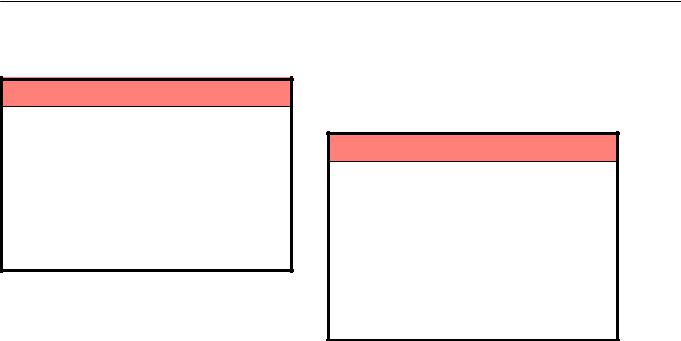
BODY
water or with lukewarm water.
Use a cloth or sponge. As you are cleaning, check the belts for excessive wear, fraying or cuts.
NOTICE
Use a good foam±type shampoo to clean the carpets.
Do not use dye or bleach on the belts ± it may weaken them.
Do not use the belts until they become dry.
The windows may be cleaned with any household window cleaner.
When cleaning the inside of the rear window, be careful not to scratch or damage the heater wires.
Air Conditioning Control Panel, Car
Audio, Instrument Panel, Console Panel,
and Switches
Use a soft damp cloth for cleaning.
Soak a clean soft cloth in water or lukewarm water then lightly wipe off any dirt.
NOTICE
Do not use organic substances (solvents, kerosene, alcohol, gasoline, etc.) or alkaline or acidic solutions. These chemicals can cause discoloring, staining or peeling of the surface.
If you use cleaners or polishing agents, make sure their ingredients do not include the substances mentioned above.
If you use a liquid car freshener, do not spill the liquid onto the vehicle's interior surfaces. It may contain the ingredients mentioned above. Immediately clean any spill using the method mentioned above.
If you have any questions about the cleaning of your Lexus, your local Lexus dealer will be pleased to answer them.
451

REPORTING SAFETY DEFECTS
FOR U.S. OWNERS
If you believe that your vehicle has a defect which could cause a crash or could cause injury or death, you should immediately inform the National Highway Traffic Safety Administration (NHTSA) in addition to notifying Toyota Motor Sales, U.S.A., Inc. (Toll±free: 1±800±25±LEXUS).
If NHTSA receives similar complaints, it may open an investigation, and if it finds that a safety defect exists in a group of vehicles, it may order a recall and remedy campaign. However, NHTSA cannot become involved in individual problems between you, your dealer, or Toyota Motor Sales, U.S.A., Inc.
To contact NHTSA, you may either call the Auto Safety Hotline toll±free at
452
SECTION 7
REPORTING SAFETY DEFECTS FOR U.S. OWNERS
Reporting safety defects for U.S. owners . . . . . . . . . 452
1±800±424±9393 (or 366±0123 in Washington.D.C. area) or write to: NHTSA, U.S. Department of Transportation, Washington. D.C. 20590. You can also obtain other information about motor vehicle safety from the Hotline.

SECTION 6 ± 4
SERVICE PROCEDURES AND
SPECIFICATIONS
Electrical components
Specifications . . . . . . . . . . . . . . . . . . . . . . . . . . . . . . . . 409
Checking battery condition . . . . . . . . . . . . . . . . . . . . . 415
Battery recharging precautions . . . . . . . . . . . . . . . . . 422
Checking and replacing the blade type fuses . . . . . 423
Checking the cartridge type fuses . . . . . . . . . . . . . . . 429
Adding washer fluid . . . . . . . . . . . . . . . . . . . . . . . . . . . 432
Checking the headlight aim . . . . . . . . . . . . . . . . . . . . . 432
Replacing light bulbs . . . . . . . . . . . . . . . . . . . . . . . . . . 435
408
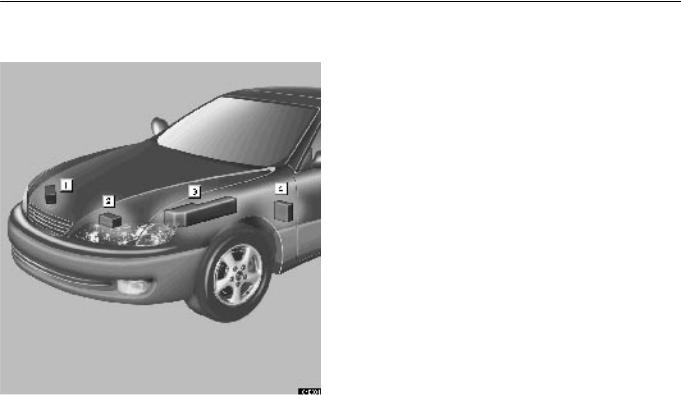
ELECTRICAL COMPONENTS
SPECIFICATIONS
± FUSE LOCATIONS
409
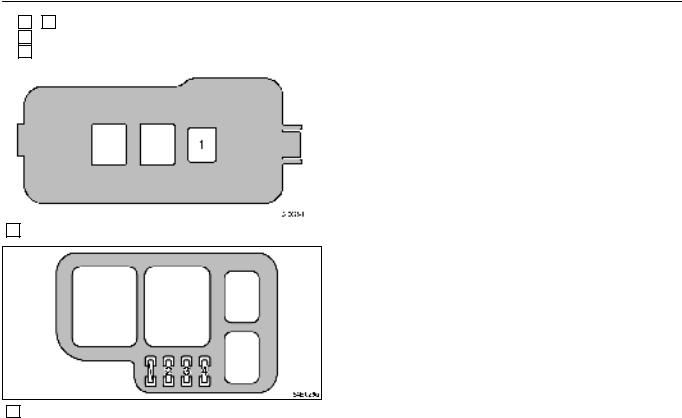
ELECTRICAL COMPONENTS
1 |
3 Engine compartment |
|
± FUSES |
|
2 |
Engine compartment |
|
|
|
4 |
Driver's side instrument panel |
|
|
|
|
|
|
|
|
|
|
|
|
|
|
|
|
|
|
|
|
|
|
|
1 Engine compartment
2 Engine compartment
410
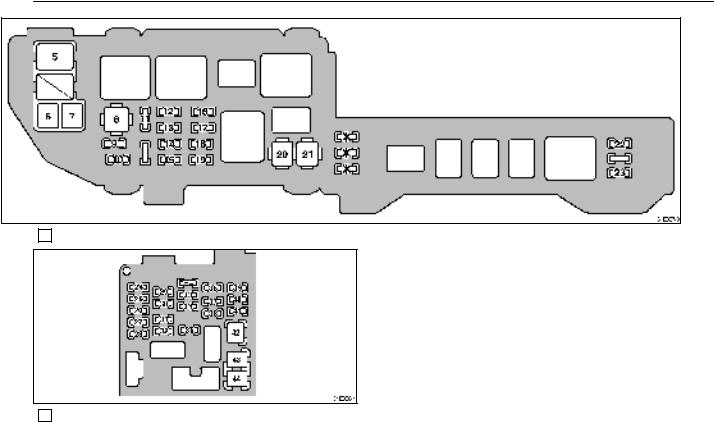
ELECTRICAL COMPONENTS
3 Engine compartment
4 Driver's side instrument panel
411

ELECTRICAL COMPONENTS
No. |
FUSE |
AMPERE |
CIRCUIT |
|
|
|
|
|
|
1 |
ABS |
60 |
Anti±lock brake system |
|
|
|
|
|
|
2 |
DRL NO.2 |
5 |
Daytime Running Light System |
|
|
|
|
|
|
3 |
HEAD |
10 |
Left±hand headlight (low beam) |
|
LH (LWR) |
|
|||
|
|
|
||
|
|
|
|
|
4 |
HEAD |
10 |
Right±hand headlight (low |
|
RH (LWR) |
beam) |
|||
|
|
|||
|
|
|
|
|
5 |
ALT |
100 |
Charging system |
|
|
|
|
|
|
6 |
T±STK |
40 |
No circuit |
|
|
|
|
|
|
7 |
HTR |
50 |
Air conditioning system, Seat |
|
heater |
||||
|
|
|
||
|
|
|
|
|
8 |
MAIN |
40 |
Headlight, Starting system |
|
|
|
|
|
|
|
|
|
Theft deterrent system, Clock, |
|
9 |
DOME |
7.5 |
Door courtesy light, Interior |
|
light, Ignition switch light, Vanity |
||||
|
|
|
light, Wireless remote control |
|
|
|
|
system |
|
|
|
|
|
|
10 |
ECU±B |
10 |
Air conditioning system, |
|
Power seat system |
||||
|
|
|
||
|
|
|
|
|
11 |
RAD NO.1 |
20 |
Audio system |
|
|
|
|
|
|
12 |
HAZARD |
10 |
Emergency flashers, Turn |
|
signal lights |
||||
|
|
|
||
|
|
|
|
412

ELECTRICAL COMPONENTS
No. |
FUSE |
AMPERE |
CIRCUIT |
|
|
|
|
|
|
13 |
AM2 |
30 |
Starting system |
|
|
|
|
|
|
14 |
TEL |
5 |
Telephone |
|
|
|
|
|
|
15 |
HEAD |
15 |
Left±hand headlight (high |
|
LH (UPR) |
beam) |
|||
|
|
|||
|
|
|
|
|
16 |
ALT±S |
5 |
Charging system |
|
|
|
|
|
|
17 |
HEAD RH |
15 |
Right±hand headlight |
|
(UPR) |
(high beam) |
|||
|
|
|||
|
|
|
|
|
18 |
EFI |
15 |
Multiport fuel injection |
|
|
|
|
|
|
19 |
HORN |
10 |
Theft deterrent system |
|
|
|
|
|
|
20 |
RDI |
30 |
Electronic cooling fan |
|
system |
||||
|
|
|
||
|
|
|
|
|
21 |
CDS |
30 |
Air conditioning system |
|
|
|
|
|
|
22 |
A/F HTR |
25 |
Air fuel ration sensor |
|
|
|
|
|
|
23 |
A/C |
10 |
No circuit |
|
|
|
|
|
|
24 |
SEAT± |
20 |
Seat heater system |
|
HEATER |
|
|||
|
|
|
||
|
|
|
|
|
25 |
HEATER |
10 |
Air conditioning system |
|
|
|
|
|
|
|
|
|
Gauges and meters, |
|
|
|
|
service reminder |
|
26 |
GAUGE |
10 |
indicators and warning |
|
buzzers, Back±up light, |
||||
|
|
|
Door courtesy light, Seat |
|
|
|
|
heater, Power window |
|
|
|
|
system |
|
|
|
|
|
No. |
FUSE |
AMPERE |
CIRCUIT |
|
|
|
|
|
|
27 |
WIPER |
25 |
Windshield wipers and |
|
washer |
||||
|
|
|
||
|
|
|
|
|
28 |
MIRROR± |
10 |
Outside rear view mirror |
|
HTR |
defogger |
|||
|
|
|||
|
|
|
|
|
|
|
|
Cruise control system, |
|
|
|
|
Anti±lock brake system, |
|
29 |
ECU±IG |
15 |
Shift lock system, Theft |
|
deterrent system, |
||||
|
|
|
Electronic modulated |
|
|
|
|
suspension, Wireless |
|
|
|
|
remote control |
|
|
|
|
|
|
30 |
IGN |
5 |
SRS, Multiport fuel |
|
injection |
||||
|
|
|
||
|
|
|
|
|
|
|
|
Stop lights, High mounted |
|
|
|
|
stoplight, Cruise control |
|
|
|
|
system, Electronic |
|
31 |
STOP |
15 |
modulated suspension, |
|
Anti±lock brake system, |
||||
|
|
|
||
|
|
|
Shift lock system, Power |
|
|
|
|
seat system, Multiport |
|
|
|
|
fuel injection |
|
|
|
|
|
|
32 |
TAIL |
10 |
Tail light, Side marker |
|
lights, License plate lights |
||||
|
|
|
||
|
|
|
|
|
33 |
POWER± |
15 |
Power outlet |
|
OUTLET |
|
|||
|
|
|
||
|
|
|
|
|
34 |
OBD |
7.5 |
On±board diagnosis |
|
system |
||||
|
|
|
||
|
|
|
|
|
35 |
FOG |
15 |
Fog lights |
|
|
|
|
|
413

ELECTRICAL COMPONENTS
No. |
FUSE |
AMPERE |
CIRCUIT |
|
|
|
|
|
|
36 |
STARTER |
5 |
Starting system |
|
|
|
|
|
|
|
|
|
Door courtesy light, Theft |
|
37 |
DOOR |
25 |
deterrent system, Power |
|
door lock system, Trunk |
||||
|
|
|
lid opener, Fuel filler door |
|
|
|
|
opener |
|
|
|
|
|
|
38 |
PANEL |
7.5 |
Instrument panel lights, |
|
Glovebox light |
||||
|
|
|
||
|
|
|
|
|
39 |
TURN |
7.5 |
Emergency flashers, Turn |
|
signal lights |
||||
|
|
|
||
|
|
|
|
40 |
RAD± |
7.5 |
Audio system |
|
NO.2 |
|
|||
|
|
|
||
|
|
|
|
|
41 |
CIG |
15 |
Cigarette lighter, Clock, |
|
SRS |
||||
|
|
|
||
|
|
|
|
|
|
|
|
Rear window defogger, |
|
42 |
DEF |
40 |
Outside rear view mirror |
|
|
|
|
defogger |
|
|
|
|
|
|
|
|
|
Power window, Electronic |
|
43 |
PWR |
30 |
moon roof, Power seat |
|
|
|
|
system |
|
|
|
|
|
|
44 |
AM1 |
40 |
No circuit |
|
|
|
|
|
|
|
SPARE |
|
Spare fuse |
|
|
|
|
|
414

ELECTRICAL COMPONENTS
CHECKING BATTERY
CONDITION
Precautions
415
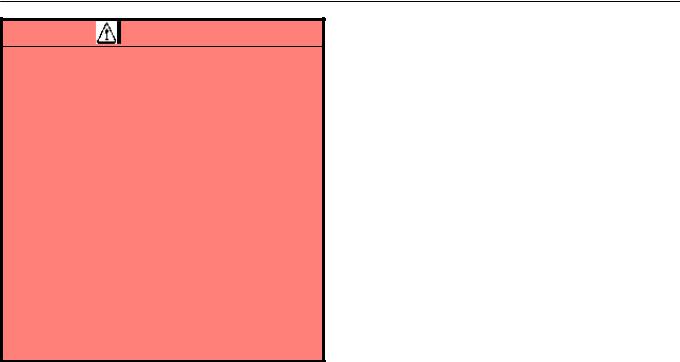
ELECTRICAL COMPONENTS
CAUTION
BATTERY PRECAUTIONS
The battery produces flammable and explosive hydrogen gas.
Do not cause a spark by contacting the battery terminals with tools.
Do not smoke or light a match near the battery.
The electrolyte contains poisonous and corrosive sulfuric acid.
Avoid contact with eyes, skin or clothes.
Never inhale or swallow electrolyte.
Wear protective safety glasses when working near the battery.
Keep children away from the battery.
EMERGENCY MEASURES
If electrolyte gets in your eyes, flush your eyes with clean water for at least 15 minutes and get immediate medical attention. If possible, continue to apply water with a sponge or cloth while traveling to the medical office.
416
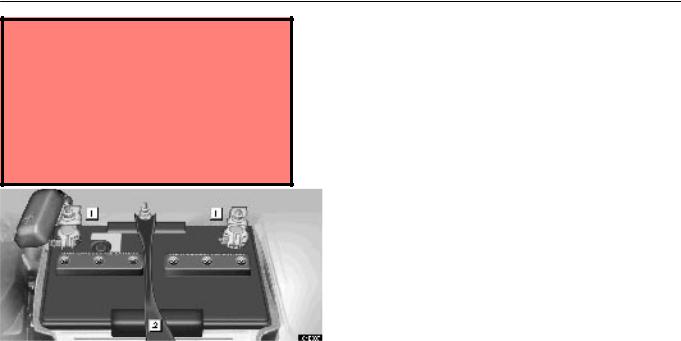
ELECTRICAL COMPONENTS
If electrolyte gets on your skin, thoroughly wash the contacted area. If you feel a pain or burn, get medical attention immediately.
If electrolyte gets on your clothes, there is a possibility of its soaking through to your skin, so immediately take off the exposed clothing and follow the procedure above, if necessary.
If you happen to swallow electrolyte, drink a large quantity of water or milk. Follow with milk of magnesia, beaten raw egg or vegetable oil. Then go immediately for emergency help.
Checking battery exterior
417

ELECTRICAL COMPONENTS
1 Terminals 2 Hold±down clamp
Check the battery for corroded or loose connections, cracks, or loose hold±down clamps.
1.If the battery is corroded, wash it off with a solution of warm water and baking soda. Coat the terminals with grease to prevent further corrosion.
2.If the connections are loose, tighten the clamp bolts
± but do not overtighten.
3.Tighten the hold±down clamp only enough to keep the battery firmly in place. Overtightening may damage the battery case.
NOTICE
Make sure the engine and all accessories are turned off before performing maintenance.
When checking the battery, remove the ground cable first and reinstall it last.
Be careful not to cause a short circuit with tools.
Take care no solution gets into the battery when washing it.
Checking battery fluid
There are 2 types of batteries: maintenance type and non±maintenance type.
A non±maintenance battery has ºMAINTENANCE FREE BATTERYº on its top. A maintenance type battery does not have such indication.
Maintenance type battery
Check the fluid condition by the fluid level lines on the side of the battery. Or if the battery has a hydrometer on its top, you can also check the hydrometer.
Non±maintenance battery
Check the battery condition by the hydrometer on the top of the battery.
418

ELECTRICAL COMPONENTS
(a) Checking by the fluid level lines (Maintenance type battery only)
1 Upper line 2 Lower line |
(b) Checking by the hydrometer |
The fluid (electrolyte) level must be between the upper and lower lines.
When checking the fluid level, look at all six cells, not just one or two.
If the level is lower than the lower line, add distilled water. (See ºAdding distilled waterº on page 421.)
419
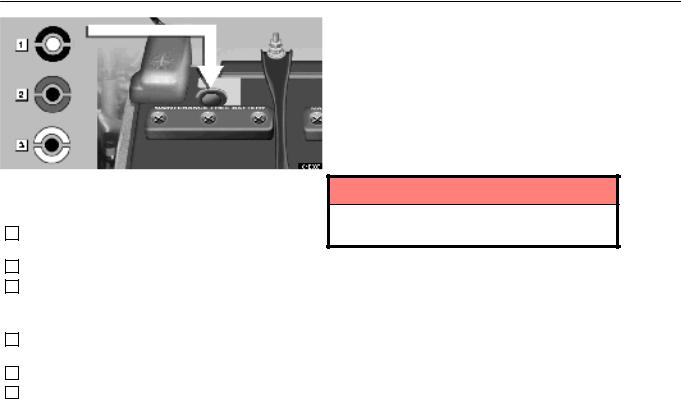
ELECTRICAL COMPONENTS
Check the battery condition by the hydrometer color.
Maintenance type battery
1RED ± Add distilled water. (See ºAdding distilled waterº on page 421.)
NOTICE
(For non±maintenance battery):
Do not refill the battery with water.
2BLUE ± Good condition.
3WHITE ± Charging necessary. Have the battery checked by your Lexus dealer.
Non±maintenance type battery
1RED ± Have the battery checked by your Lexus dealer.
2BLUE ± Good condition.
3WHITE ± Charging necessary. Have the battery checked by your Lexus dealer.
420

ELECTRICAL COMPONENTS
Adding distilled water (Maintenance type battery only)
421
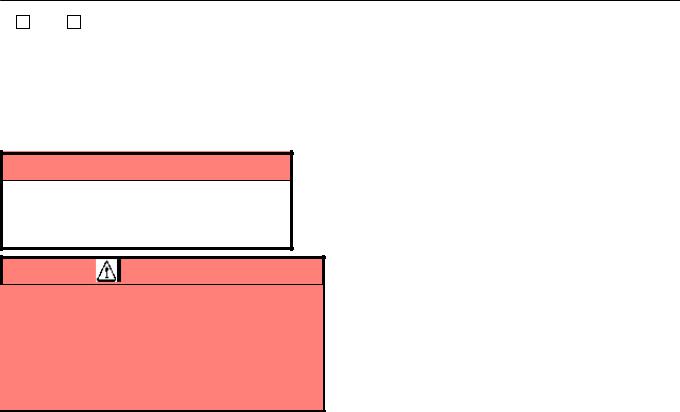
ELECTRICAL COMPONENTS
1 Low 2 O.K.
1.Remove the vent plugs.
2.Add distilled water to cells needing fluid.
If the side of your battery is covered, check the water level by looking down directly above the cell as illustrated above.
3. Retighten the vent plugs securely.
NOTICE
Do not overfill the cells. Excess electrolyte could squirt out of the battery during heavy charging, causing corrosion or damage.
Use a cover on the battery for longer life.
BATTERY RECHARGING
PRECAUTIONS
During recharging, the battery is producing hydrogen gas.
Therefore, before recharging:
1.Maintenance type batteries ± Remove the vent plugs.
2.If recharging with the battery installed on the vehicle, be sure to disconnect the ground cable.
3.Make sure the power switch on the recharger is off when connecting the charger cables to the battery and when disconnecting them.
CAUTION
Always charge the battery in an unconfined area. Do not charge the battery in a garage or closed room where there is not sufficient ventilation.
Non±maintenance batteries: Only do a slow charge (5 A or less). Charging at a quicker rate is dangerous. The battery may explode causing personal injuries.
Maintenance type batteries: Be sure to remove the vent plugs before recharging.
422

ELECTRICAL COMPONENTS
NOTICE
Never recharge the battery while the engine is running. Also, be sure all accessories are turned off.
CHECKING AND REPLACING THE BLADE TYPE FUSES
423
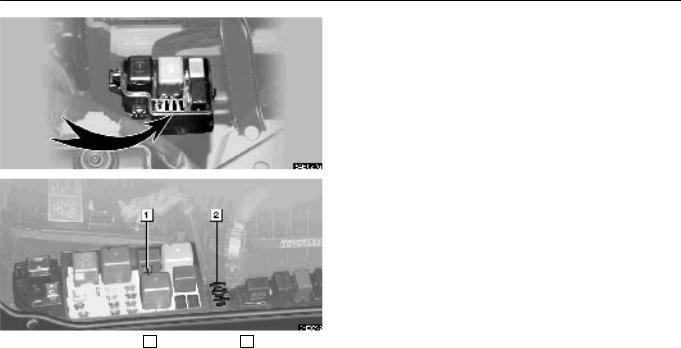
ELECTRICAL COMPONENTS
Engine compartment 1 Pull±out tool 2 Spare fuses
424

ELECTRICAL COMPONENTS
Driver's side instrument panel
1. Turn the ignition switch off and remove the auxiliary box.
Determine which fuse may be causing the problem. The auxiliary box shows the name of the circuit for each fuse.
425

ELECTRICAL COMPONENTS
2. Make sure the inoperative component is turned off. Pull the suspected fuse straight out with the pull±out tool and check it. If it has blown, push a new fuse into the clips.
426
